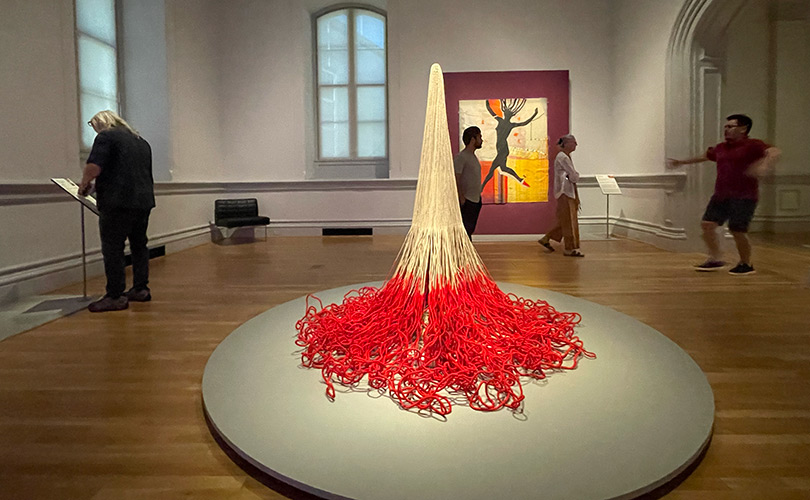
We were very excited to visit Subversive, Skilled, Sublime: Fiber Art by Women last month, just after it opened at the Renwick Gallery at the Smithsonian American Art Museum in Washington, D.C. Besides thoroughly enjoying the engaging exhibition, we were pleased to catch up with senior curator of the exhibition, Mary Savig, friend of the gallery, Kathleen Mangan of the Lenore Tawney Foundation, and artist, Lia Cook (and see her exquisite work, Crazy Too Quilt).

As the Gallery notes explain, the 33 selected artworks in Subversive, Skilled Sublime piece together an alternative history of American art. Accessible and familiar, fiber handicrafts have long provided a source of inspiration for women. The artists in this exhibition took up fiber arts, dismissed by many art critics as menial labor, to complicate this historic marginalization and also revolutionize its import to contemporary art. They drew on personal experiences, particularly their vantage points as women, and intergenerational skills, to transform humble threads into resonant and intricate artworks.

The works in the exhibition are artfully displayed. From the dramatic Claire Zeisler at the entrance to the exhibition, to the Lenore Tawney Cloud in the room just behind, to the narrow circular alcove where an ethereal Kay Sekimachi monofilament hangs in space, there are many vignettes that delight. We had a few (maybe more than a few) favorites. Lenore Tawney’s In the Dark Woods from 1959 is a revelation. It represents the artist’s open warp technique in which she pulled fiber through the vertical threads (the warp) by hand to create painterly, gestural forms. Unveiling of the Statue of Liberty is an exceptional Katherine Westphal quilt. We also loved Faith Ringgold’s The Bitter Nest, Part II: The Harlem Renaissance Party and its fascinating backstory.

New to us was A Matter of Trust, Maria Emilia-Faedo’s quilt of metal mesh. “I collected secrets from friends and strangers, sealed them in ordinary envelopes, and sewed them into the quilt’s pockets,” the artist told Paradise News magazine. The envelopes containing the secrets are known only to their authors and were never read by Emilia-Faedo. We also loved Red and Blue, the 1969 work by Else Regensteiner.

We were also impressed by the dedicated gallery space of archival materials, and spent a good amount of time there. It provides a window into the artists’ studios, deepening insight into their creative processes with sketches, mail art, and photographs. There are many resources on line, including portraits of a few of the artists. All of the artworks are drawn from the Smithsonian American Art Museum’s permanent collection; archival materials and interviews are selected from collections of the Archives of American Art.

You have until January 5, 2025 to see Subversive, Skilled, Sublime. In the meantime, you can see work by four of the artists in Sublime, Katherine Westphal, Adela Akers, Lia Cook, and Kay Sekimachi at browngrotta arts’ in Impact: 20 Women Artists to Collect, part of our fall exhibition, Ways of Seeing.
